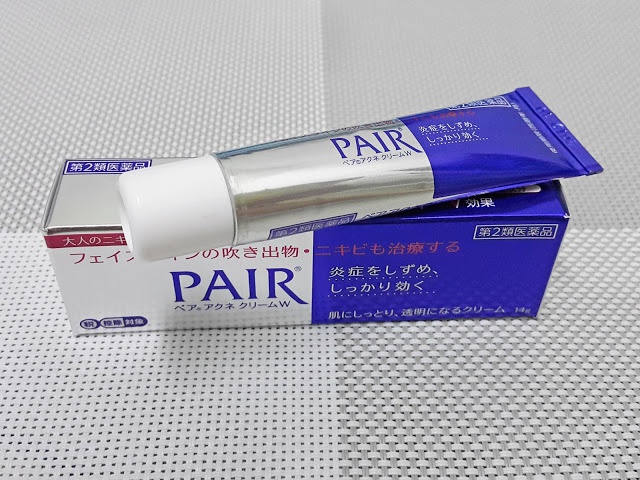
Ingredients overview
Highlights
Skim through
LION Pair Acne Cream WIngredients explained


A handy multi-tasker, white to light yellowish oil-loving wax that works very well in oil-in-water emulsions. It makes your skin feel nice and smooth (emollient), stabilizes oil-water mixes and gives body to them.
Oh, and one more thing: it's a so-called fatty alcohol - the good, emollient type of alcohol that is non-drying and non-irritating. It is often mixed with fellow fatty alcohol, Cetyl Alcohol, and the mixture is called Cetearyl Alcohol in the ingredient list.
A common little helper ingredient that helps water and oil to mix together, aka emulsifier.
Super common little helper ingredient that helps products to remain nice and stable for a longer time. It does so by neutralizing the metal ions in the formula (that usually get into there from water) that would otherwise cause some not so nice changes.
It is typically used in tiny amounts, around 0.1% or less.
Unless you live under a rock, you have probably heard of parabens. Until about 10 years ago they were the most commonly used preservatives, as they are non-irritating, very effective, and cheap.
Then 2004 came and a research paper came out that tested 20 human breast tumors and found parabens in all of them. This was before the era of social media (btw, it's the year Facebook was founded) but this research still managed to go viral and caused parabens to become the evil, cancer-causing preservative in people's head.
Cosmetic companies do want to do what we want to buy and as we did not want to buy products, containing parabens anymore, they started to use alternatives, like the current IT-preservative, phenoxyethanol. It's much easier to replace parabens than trying to go into lengthy explanations about why the 2004 research is misunderstood and how there are lots of data showing that parabens are totally ok.
As people got so interested, the FDA wrote a little article about parabens stating, " (the)FDA believes that at the present time there is no reason for consumers to be concerned about the use of cosmetics containing parabens."
We think the above is pretty much the gist of the topic but if you feel like reading about parabens all day today, here is a handy list for you to get you started:
- Parabens on Wikipedia
- The perils of parabens by cosmetic chemist Perry Romanowski on the great The Beauty Brains blog
- Spotlight on parabens by Nicki Zevola on the Futerederm blog
- Fact-Check Friday: What’s The Deal with Parabens in Cosmetics? on the great LabMuffin blog

A clear, slightly yellow, odorless oil that's a very common, medium-spreading emollient. It makes the skin feel nice and smooth and works in a wide range of formulas.
Butylene glycol, or let’s just call it BG, is a multi-tasking colorless, syrupy liquid. It’s a great pick for creating a nice feeling product.
BG’s main job is usually to be a solvent for the other ingredients. Other tasks include helping the product to absorb faster and deeper into the skin (penetration enhancer), making the product spread nicely over the skin (slip agent), and attracting water (humectant) into the skin.
It’s an ingredient whose safety hasn’t been questioned so far by anyone (at least not that we know about). BG is approved by Ecocert and is also used enthusiastically in natural products. BTW, it’s also a food additive.
A big molecule created from repeated subunits (a polymer of acrylic acid) that magically converts a liquid into a nice gel formula. It usually has to be neutralized with a base (such as sodium hydroxide) for the thickening to occur and it creates viscous, clear gels that also feel nice and non-tacky on the skin. No wonder, it is a very popular and common ingredient. Typically used at 1% or less in most formulations.
Exactly what it sounds: nice smelling stuff put into cosmetic products so that the end product also smells nice. Fragrance in the US and parfum in the EU is a generic term on the ingredient list that is made up of 30 to 50 chemicals on average (but it can have as much as 200 components!).
If you are someone who likes to know what you put on your face then fragrance is not your best friend - there's no way to know what’s really in it.
Also, if your skin is sensitive, fragrance is again not your best friend. It’s the number one cause of contact allergy to cosmetics. It’s definitely a smart thing to avoid with sensitive skin (and fragrance of any type - natural is just as allergic as synthetic, if not worse!).
You may also want to take a look at...
| what‑it‑does | preservative | antimicrobial/antibacterial |
| what‑it‑does | emollient | viscosity controlling | emulsifying | surfactant/cleansing |
| irritancy, com. | 2, 2 |
| what‑it‑does | emulsifying | surfactant/cleansing |
| what‑it‑does | chelating |
| what‑it‑does | preservative |
| what‑it‑does | emollient | perfuming |
| what‑it‑does | moisturizer/humectant | solvent |
| irritancy, com. | 0, 1 |
| what‑it‑does | viscosity controlling |
| irritancy, com. | 0, 1 |
| what‑it‑does | perfuming |





